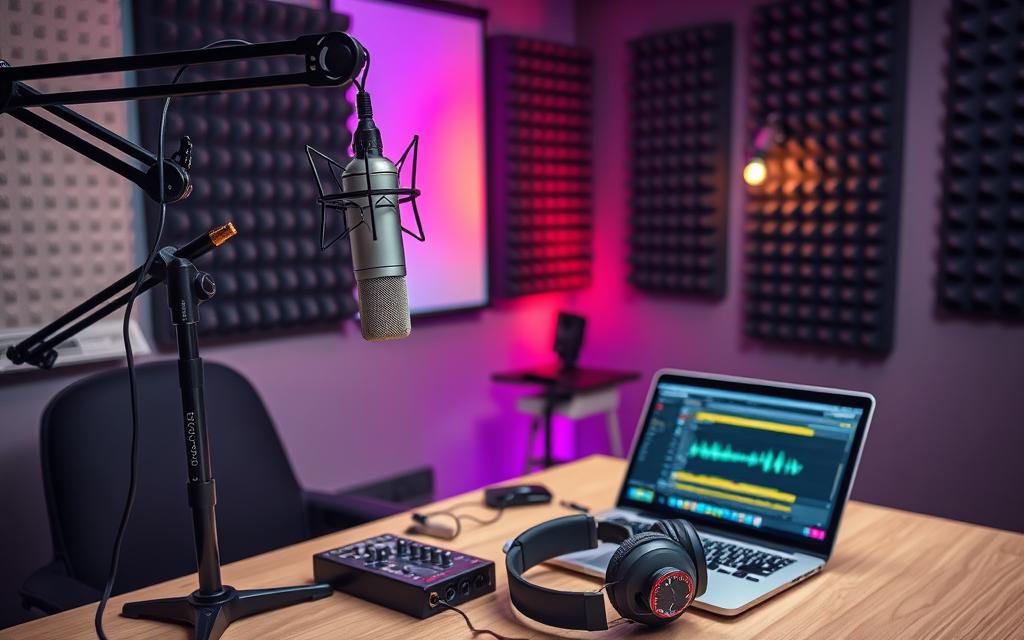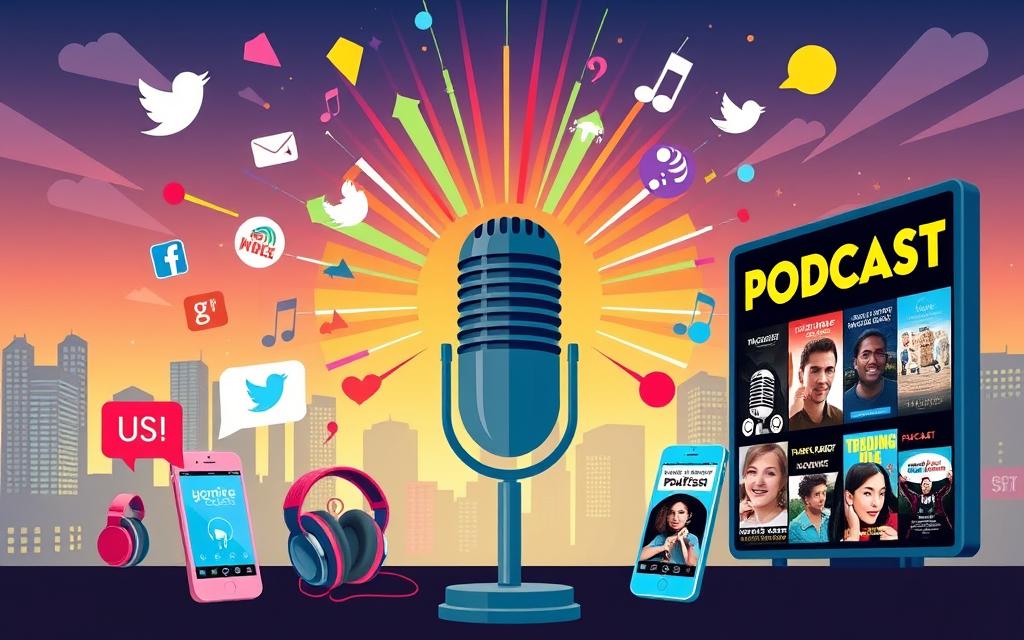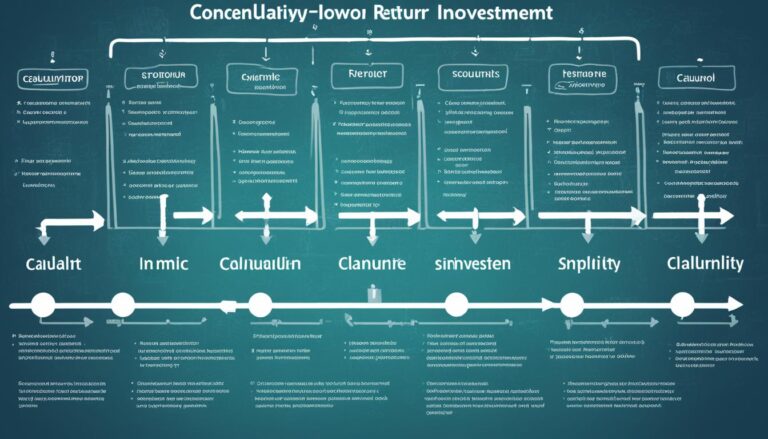Podcasting: Your Guide to Audio Storytelling
Did you know over 50% of Americans have listened to a podcast? This shows how fast podcasting is growing. It’s a great way for creators to reach people all over the world. This guide will help you get into podcasting, showing how it connects people and sparks creativity.
Podcasting lets people share their thoughts and stories easily. Listeners can enjoy them while doing other things. Thanks to technology, making and listening to podcasts is now simple. Let’s see how you can use podcasting to share your voice.
Key Takeaways
- Podcasting is a rapidly growing medium with over half of Americans listening at least once.
- The convenience of on-demand audio allows for storytelling anytime, anywhere.
- Digital broadcasting has democratized content creation, requiring minimal equipment.
- Diverse podcast formats cater to a wide range of storytelling styles and interests.
- Engaging scripts and unique voices enhance podcast content significantly.
Understanding Podcasting as a Medium
Podcasting has changed how we listen to audio content. It creates a personal connection between listeners and hosts. This connection makes listeners feel like they’re part of a private conversation.
Podcasts are perfect for on-demand media. You can listen to them anytime, anywhere. This makes podcasts even more appealing.
The Intimacy of Audio Communication
Audio is powerful because it can share emotions and real feelings. Listening to podcasts feels like talking to a friend. This makes listeners loyal and engaged.
Trust is key in podcasting. Listeners feel they’re getting real insights from people they admire. As podcasting grows, these connections will get stronger.
The Growing Popularity of On-Demand Media
On-demand media has changed how we watch and listen. It lets us access many podcasts anytime. This has made podcasting more popular.
More people, especially young ones, are listening to podcasts. In 2023, 42% of Americans aged 12 and older listened to podcasts. This shows a big change in how we consume media.
Advertisers are now using podcasts to reach their audience. Podcasts offer a way to connect with people who might not watch TV or listen to the radio. As podcasting grows, understanding its unique qualities is key for creators and advertisers.
Types of Podcast Formats
The world of podcasts is filled with different formats, each appealing to various listeners. Knowing these formats helps new podcasters pick the best style for their content and audience.
Monologue Podcasts
Monologue podcasts have one host sharing stories or discussions all by themselves. This style lets hosts dive deep into topics, making a strong bond with listeners. Shows like Dan Carlin’s Hardcore History are great examples, drawing people in with their detailed stories and personal views.
Interview Podcasts
Interview podcasts are a favorite, blending stories with lively chats. They can feature experts or celebrities, offering insights and tales. Shows like The StartUp Podcast and Death, Sex & Money are hits, drawing in many listeners with their interesting content.
Narrative and Fictional Narrative Podcasts
Narrative and fictional podcasts have become very popular, offering deep, engaging stories. They use great storytelling and sound effects, making shows like Welcome to Night Vale feel like radio dramas. With lower costs, more creators can make these engaging stories, reaching a wide audience.
Creating Compelling Audio Content
To make audio content that sticks, focus on writing scripts for listening. Make sure your content is clear and to the point. This will keep your audience hooked.
Stories in your scripts make them more memorable. Adding tips or advice makes your content valuable. This makes listeners want to come back for more.
Writing for the Ear: Crafting Engaging Scripts
Understanding what your audience likes is key when writing scripts. Use surveys or social media to get their feedback. This helps you create content they’ll enjoy.
Bring in guests who are experts but not well-known. Their fresh views add excitement to your podcast. Being real and true to yourself connects you with your listeners.
Finding Your Unique Podcast Voice
A unique voice is what makes a podcast stand out. Discover your storytelling style and how you deliver it. Listen to others for inspiration, but be original.
Each episode should show your passion and be true to yourself. This invites listeners into your world. Keeping a consistent tone builds your brand and loyalty.
Recording and Editing Your Podcast
Creating a great podcast starts with good recording and editing. The right editing software can make your podcast sound better. It’s important to choose software that fits your needs.
Essential Podcast Editing Software
Popular choices include Audacity, Adobe Audition, and GarageBand. These tools help improve your audio. Audacity is free and easy to use, while GarageBand is for Mac users. Descript is also great, offering both audio and video editing.
Setting Up a Home Studio
A good home studio is key. You’ll need a quality USB microphone for better sound. Add a pop filter and boom arm to make recording easier. Proper setup and soundproofing help keep your audio clear.
Audio Quality: Best Practices for Recording
Keep your recording levels consistent for the best sound. Aim for 10dB to avoid distortion. Cut out filler words and false starts to make your podcast better. Listen on headphones and speakers to ensure it sounds good to everyone.

Podcast Hosting and Distribution
Choosing the right podcast hosting service is key for spreading your podcast far and wide. There are many options, each with its own set of features and prices. Look at storage, analytics, and support when picking a service.
Libsyn, Blubrry, and Podbean are top picks in the podcast world. Podbean, for example, supports over 145,476 active podcasts. It offers plans from $0 to $79 a month, making it great for both new and seasoned podcasters. For more info, check out this guide to podcast hosting.
Choosing the Right Podcast Hosting Service
Every hosting service meets different needs, affecting your podcast’s success. Transistor offers plans from $19 to over $199 a month, serving about 26,000 podcasts. Buzzsprout also has a free 90-day trial, letting you try before you buy.
This flexibility is crucial for podcasters wanting to start strong without breaking the bank.
Understanding RSS Feeds for Podcasting
RSS feeds are essential for podcast distribution. They help share your episodes on platforms like Apple Podcasts, Spotify, and Google Podcasts. By setting up your feed right, new episodes will update on these platforms after approval.
This keeps your listeners coming back for more. Knowing how RSS feeds work helps your podcast reach more people, increasing your listenership.
Promoting Your Podcast
Getting your podcast noticed is key to growing your audience. With over 4 million podcasts worldwide, it’s tough to stand out. Using platforms like Apple Podcasts or Spotify can help you reach new listeners. By strategically placing your podcast in these spots, you can boost your visibility and attract more fans.

Utilizing Podcast Directories Effectively
Being active in podcast directories is crucial for promotion success. Asking listeners to leave reviews on Apple Podcasts can help your podcast shine. It’s also smart to use the features these platforms offer to draw in more listeners. For instance, being highlighted in a key section can move your podcast up the ranks quickly.
Social Media Strategies for Promotion
Using social media wisely can really help promote your podcast. Share updates, sneak peeks, and interact with your listeners to build a community. Team up with other podcasters to reach more people. QR codes can make sharing your podcast easy and trackable. Having a dedicated website for your podcast can also boost your brand and SEO.
Discover ways to integrate yourpromotional efforts, ensuring that every channel works in harmony to bring new listeners to your show.
Podcast Monetization Strategies
Monetizing a podcast needs a mix of old and new ways. By understanding sponsorship and ads, podcasters can earn more. They also give value to their listeners.
Understanding Sponsorship and Advertisements
Sponsorship is a key way to make money from podcasts. Podcasters partner with brands to promote products in their shows. As more listeners join, these deals get more valuable.
Ad networks like AdvertiseCast and Midroll help connect hosts with sponsors. This makes it easier to find deals. Studies show 61% of listeners buy products after hearing about them on podcasts. This shows how effective sponsored content can be.
Alternative Monetization Methods
There are other ways to make money too. Fan-funding sites like Patreon let creators get support directly from fans. This builds a loyal community.
Many podcasts on Patreon offer special content like extra episodes or discounts. They also sell merchandise. This keeps listeners engaged. By trying different ways to make money, podcasters can earn more and connect better with their audience. For more tips, check out this guide on monetizing your podcast and learn about engagement tactics.
Podcast Analytics: Measuring Your Success
Understanding podcast analytics is key to success in podcasting. By tracking specific metrics, podcasters can learn about audience engagement and preferences. This helps improve content. Important metrics include download numbers, listener retention, and subscriber growth.
With 13 ways to measure success, analyzing trends is crucial. This includes audience reviews and ratings. It shows how your podcast impacts listeners.
Key Metrics to Track
Pay attention to metrics like unique listeners and show consumption rates. Also, look at chart ratings from Apple Podcasts. High listener retention rates, around 75%, mean your content hits the mark.
Downloads over 124 in 30 days put you in the top 50% of shows. More than 6,700 downloads gets you in the top 3%. These stats show how well your podcast connects with listeners.
Using Analytics to Improve Content
Analytics help podcasters improve their content and marketing. Positive reviews and high ratings mean your audience likes what you offer. Negative feedback is a chance to grow.
By studying audience demographics, you can make episodes more appealing. This boosts your podcast’s reputation and builds listener loyalty. It ensures your podcast keeps growing and succeeding.
FAQ
What is podcasting?
Podcasting lets creators share audio content on many topics. It uses RSS feeds to spread content across platforms. Listeners enjoy stories and conversations.
How do I start a podcast?
First, pick a theme for your podcast. Then, get good recording equipment. Choose editing software like Audacity or Adobe Audition.
Find a hosting service for your podcast. These steps help you share your podcast on different platforms.
What are the different types of podcast formats?
There are several podcast formats. Monologue podcasts have one speaker. Interview podcasts feature conversations with guests.
Narrative podcasts tell stories with sound design. Each format offers unique ways to tell stories.
How can I promote my podcast effectively?
Promote your podcast on Apple Podcasts and Spotify. Use social media to connect with listeners. Create ads that target your audience.
Staying active online helps grow your audience. It makes your podcast more visible.
What strategies can I use for podcast monetization?
Monetize your podcast through sponsorships. Use platforms like Patreon for donations. Sell merchandise too.
Trying different ways to make money helps your podcast stay financially stable.
Why is audio quality important in podcasting?
Good audio quality keeps listeners. Bad sound can lose them. Use soundproofing and the right microphones.
Editing software also improves your podcast’s sound. This makes your content more enjoyable.
How do I measure the success of my podcast?
Use analytics tools to track downloads and listeners. Look at subscriber growth too. This data helps you understand your audience.
It lets you improve your content and marketing. This way, you can better engage your listeners.







